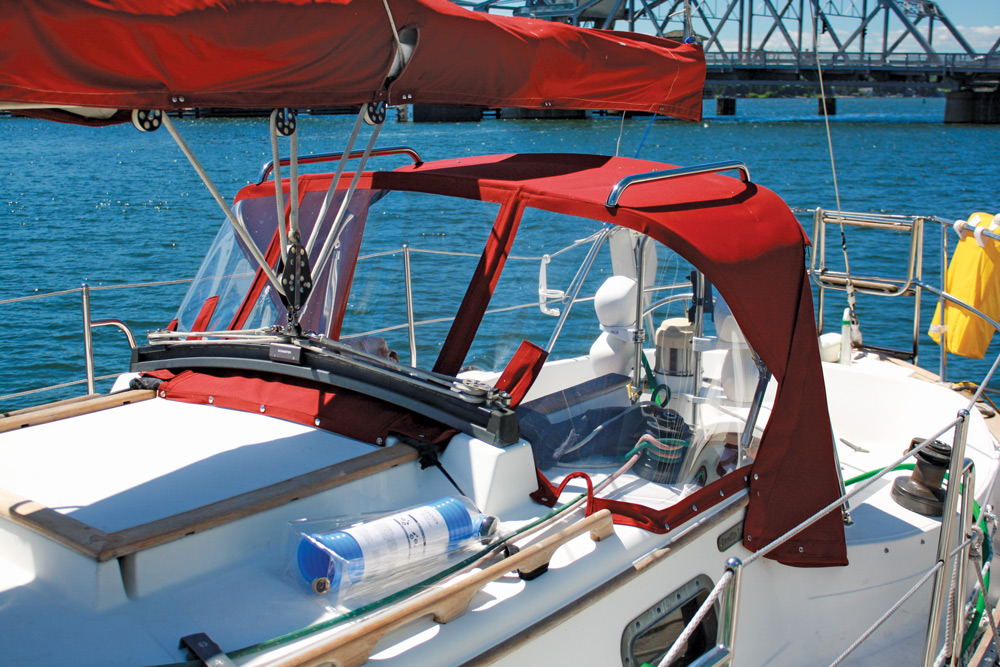Retrofitting projects
In a nod to our annual retrofitting issue, we are featuring several projects to inspire and consider for your own boat
Upgrading cockpit canvas
Canvas can add a lot of creature comfort to a boat. It helps keep sailors warm and dry and provides relief from the beating sun. But that same canvas can be a real bother sometimes. On my boat, the bimini was a few inches shorter than I am, which means I had to sit down at the helm or adapt a salty slouch. At the same time my dodger windows were cloudy. The combination of issues meant that a turn at the helm was an exercise in discomfort and eye strain. It was time for an upgrade.

I’m not afraid to take on a lot of boat projects myself, but I knew this sort of canvas project was beyond my abilities. I worked with Charlie Klein of Dorsal Sails and Canvas of Sturgeon Bay, Wisconsin, to tackle this long-overdue project. We started the project by taking stock of what I had to figure out if there was anything that could be reused. The canvas itself had to go, but some of the hardware was in good enough shape to reuse.
The bimini frames could also be reused, but they obviously had to lengthened, which required adjusting some of the support angles. Rather than rebuilding the frames, we had Manitowoc Marina weld extensions to ends to give us the height we needed. The welds were filled, ground and polished to make the extension invisible. With the frames at the correct length, Charlie maneuvered them in place to maximize the height under the boom.
Dorsal uses a high-tech method to measure for the canvas. Rather than patterning the bimini with plastic as often done, Klein digitized the frame with a Proliner. This tool produces a perfect model of the 3D surface of the bimini. With the model, Charlie can manipulate the design of the canvas in his computer before ever touching the canvas. When his is satisfied, it’s a simple process to download the canvas panels to his plotter for automated cutting. From there, it’s old school seaming and fitting, but technology has really advanced this craft.
With the bimini under control, we moved on to the dodger. My dodger actually worked pretty well, it was just getting hard to see through the windows. But as long as I was making the investment in this project, I wanted to tweak the design a little. Dodgers generally come in two forms: traditional one piece dodgers and “California” dodgers, with a freestanding top and zip-on window panels all around. The main benefit of the California style is that you can remove the windows on hot days. But I see a different benefit to the California style. Traditional dodgers are sewn into one 3D piece of canvas, which means they are great while they are up but hard to fold and store for the winter. In addition, you are forced to fold the windows and that decreases the life.
I chose a traditionally styled California dodger even though it’s unlikely I’ll ever remove the windows during the season, but the panels will be a blessing when it is time to store the canvas.
We were able to use the dodger frame as is, and planned to add hand rails to each side to add some security when coming in and out of the cockpit. Charlie was able to digitize the dodger in place so I was able to see what the new structure would look like.
A big part of a dodger are the windows, it is a canvas “windshield” after all. Window technology has really developed in the last decade. Clear vinyl windows are still pretty much the standard, though the coatings have progressed. Rigid windows are very nice because they offer glass like clarity and a long life. The most popular are rigid bonded windows, in this option thin Lexan panels are actually glued to canvas material. A newer option is Makrolon, which is a sewable rigid polycarbonate window with an abrasion resistant coating. There is even a rollable rigid option out there, Makrolon VR (vinyl replacement), this is the best of both worlds, rigid clarity but still rollable. I chose Makrolon, for ultimate clarity and long life.
Canvas is never cheap, but I consider it a great investment. I now fit under my bimini and see through my dodger, plus the boat looks great! The cost on the dodger was $2,800, the rigid windows added about 20%, and $2,100 for the bimini. The welding and handholds on the side of the dodger added another $600.
Sources:
Dorsal Sails and Canvas, www.doorsail.com, 920-743-4126; Manitowoc Marina, www.manitowoc-marina.com, 920-682-5117; Proliner, www.prodim-systems.com, 772-465-4000

Comments